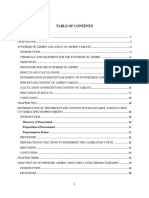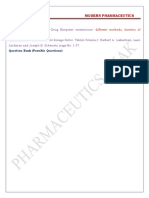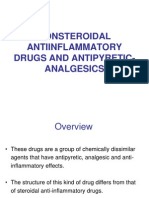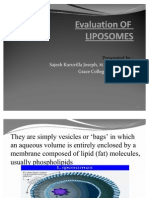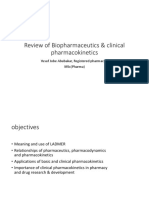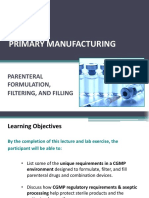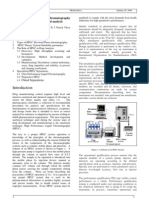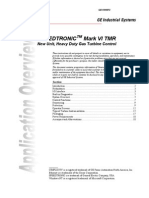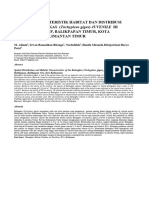High Performance Liquid Chromatography
High Performance Liquid Chromatography
Uploaded by
Sreedev SureshbabuCopyright:
Available Formats
High Performance Liquid Chromatography
High Performance Liquid Chromatography
Uploaded by
Sreedev SureshbabuOriginal Description:
Original Title
Copyright
Available Formats
Share this document
Did you find this document useful?
Is this content inappropriate?
Copyright:
Available Formats
High Performance Liquid Chromatography
High Performance Liquid Chromatography
Uploaded by
Sreedev SureshbabuCopyright:
Available Formats
Sharon Satheesan Shehinsha Siya rahman Sreedev A S Vishnu Mohan
HPLC is a form of liquid chromatography used to separate compounds that are dissolved in solution. HPLC instruments consist of a reservoir of mobile phase, a pump, an injector, a separation column, and a detector. Compounds are separated by injecting a sample mixture onto the column. The different component in the mixture pass through the column at differentiates due to differences in their partition behavior between the mobile phase and the stationary phase. The mobile phase must be degassed to eliminate the formation of air bubbles.
Adsorption Normal Phase polar bed, non polar mobile phase (n-hexane, tetrahydrofuran) Reverse Phase non-polar bed w/ polar mobile phase (methanol, water, acetonitrile mixture) most common Ion Exchange Stationary bed ionically charged surface, opposite to sample ions Use with ionic or ionizable samples Stronger charge = longer elution time Mobile Phase aqueous buffer Size Exclusion Column material precise pore sizes Large molecules first, then small
The function of the injector is to place the sample into the high-pressure flow in as narrow volume as possible so that the sample enters the column as a homogeneous, low-volume plug. To minimize spreading of the injected volume during transport to the column, the shortest possible length of tubing should be used from the injector to the column. When an injection is started, an air actuator rotates the valve: solvent goes directly to the column; and the injector needle is connected to the syringe. The air pressure lifts the needle and the vial is moved into position beneath the needle. Then, the needle is lowered to the vial.
The column is one of the most important components of the HPLC chromatograph because the separation of the sample components is achieved when those components pass through the column. The High performance liquid chromatography apparatus is made out of stainless steel tubes with a diameter of 3 to 5mm and a length ranging from 10 to 30cm. Columns are filled with silica gel because its particle shape, surface properties, and pore structure help to get a good separation. Silica is wetted by nearly every potential mobile phase, is inert to most compounds and has a high surface activity which can be modified easily with water and other agents. Silica can be used to separate a wide variety of chemical compounds, and its chromatographic behavior is generally predictable and reproducible.
Absorbance (UV with Filters, UV with Monochromators) IR Absorbance Fluorescence Refractive-Index Electrochemical Mass-Spectrometric Photo-Diode Array
Normal
phase phase
Reverse Size
exclusion
Ion
exchange
Particle
size of packings Column diameters Extra-column volume (that volume in an HPLC system between and including the injector and the detector);
In
this column type, the retention is governed by the interaction of the polar parts of the stationary phase and solute. For retention to occur in normal phase, the packing must be more polar than the mobile phase with respect to the sample
In
this column the packing material is relatively nonpolar and the solvent is polar with respect to the sample. Retention is the result of the interaction of the nonpolar components of the solutes and the nonpolar stationary phase. Typical stationary phases are nonpolar hydrocarbons, waxy liquids, or bonded hydrocarbons (such as C18, C8, etc.) and the solvents are polar aqueous-organic mixtures such as methanol-water or acetonitrile-water.
In
size exclusion the HPLC column is consisted of substances which have controlled pore sizes and is able to be filtered in an ordinarily phase according to its molecular size. Small molecules penetrate into the pores within the packing while larger molecules only partially penetrate the pores. The large molecules elute before the smaller molecules.
In
this column type the sample components are separated based upon attractive ionic forces between molecules carrying charged groups of opposite charge to those charges on the stationary phase. Separations are made between a polar mobile liquid, usually water containing salts or small amounts of alcohols, and a stationary phase containing either acidic or basic fixed sites.
This technique is used for chemistry and biochemistry research analyzing complex mixtures, purifying chemical compounds, developing processes for synthesizing chemical compounds, isolating natural products, or predicting physical properties. It is also used in quality control to ensure the purity of raw materials, to control and improve process yields, to quantify assays of final products, or to evaluate product stability and monitor degradation. In addition, it is used for analyzing air and water pollutants, for monitoring materials that may jeopardize occupational safety or health, and for monitoring pesticide levels in the environment. Federal and state regulatory agencies use HPLC to survey food and drug products, for identifying confiscated narcotics or to check for adherence to label claims.
You might also like
- A Laboratory Manual of Physical PharmaceuticsFrom EverandA Laboratory Manual of Physical PharmaceuticsRating: 2.5 out of 5 stars2.5/5 (2)
- Colour Reaction of Amino AcidsDocument27 pagesColour Reaction of Amino AcidsNicola Faye BronNo ratings yet
- Principles of Colorimetric MeasurementsDocument8 pagesPrinciples of Colorimetric MeasurementsDipmalya Basak100% (1)
- Medicinal and Environmental Chemistry: Experimental Advances and Simulations (Part I)From EverandMedicinal and Environmental Chemistry: Experimental Advances and Simulations (Part I)No ratings yet
- Anatomy - The Nervous System PowerpointDocument47 pagesAnatomy - The Nervous System Powerpointhdavoudi7100% (2)
- High Performance Liquid ChromatographyDocument11 pagesHigh Performance Liquid ChromatographyPrincess AleenaNo ratings yet
- High Performance Liquid ChromatographyDocument22 pagesHigh Performance Liquid Chromatographygenjihimora2102No ratings yet
- RP HPLCDocument9 pagesRP HPLCGoutam GhoshNo ratings yet
- HPLCDocument8 pagesHPLCShaffan MohdNo ratings yet
- 1 - Introduction To Instrumental MethodsDocument19 pages1 - Introduction To Instrumental MethodsAtongo George AtiahNo ratings yet
- Aspirin SynthesisDocument48 pagesAspirin SynthesisPaolo PepsNo ratings yet
- ANTI INFLAMMATORY Screening MethodsDocument7 pagesANTI INFLAMMATORY Screening MethodsBrajesh Thankamony75% (4)
- Quinolones: Nucleic Acid Synthesis InhibitorsDocument21 pagesQuinolones: Nucleic Acid Synthesis InhibitorsShahid Iqbal100% (1)
- Thin Layer ChromatographyDocument16 pagesThin Layer ChromatographyDr. M. Prasad Naidu100% (1)
- Liquid Orals DeepsDocument58 pagesLiquid Orals Deepsjalsadeeps1100% (1)
- Drug Metabolism: Presenter:-Dr Swaroop H S Moderator: - DR Ananya ChakrabortyDocument38 pagesDrug Metabolism: Presenter:-Dr Swaroop H S Moderator: - DR Ananya Chakrabortyadinda keanayaNo ratings yet
- Visible and Ultraviolet Spectroscopy-Part 2Document54 pagesVisible and Ultraviolet Spectroscopy-Part 2Amusa TikunganNo ratings yet
- Drug Extraction RatioDocument8 pagesDrug Extraction RatioHeru Fajar SyaputraNo ratings yet
- GlycosidesDocument18 pagesGlycosidesAnonymous TCbZigVqNo ratings yet
- Non Aqueous TitrationDocument7 pagesNon Aqueous TitrationMohamed Ali AllamyNo ratings yet
- Introduction To HPLCDocument40 pagesIntroduction To HPLCSunil KumarNo ratings yet
- Chemistry of FlavonoidsDocument15 pagesChemistry of FlavonoidsSathish SizzyNo ratings yet
- High Pressure Liquid Chromatography (HPLC) PDFDocument13 pagesHigh Pressure Liquid Chromatography (HPLC) PDFmitalNo ratings yet
- Drug MetabolismDocument78 pagesDrug Metabolismjuz gonzagaNo ratings yet
- Drug Elimination: Termination of Drug ActionDocument80 pagesDrug Elimination: Termination of Drug ActionLidyaNo ratings yet
- Basic Principles of HPLCDocument18 pagesBasic Principles of HPLCshahzad1840100% (2)
- Chapter-1 Modern PharmaceuticsDocument35 pagesChapter-1 Modern PharmaceuticsTarun ChauhanNo ratings yet
- Placebo-Controlled StudiesDocument2 pagesPlacebo-Controlled StudiesPharm Orok100% (1)
- SpectrofluorimetryDocument3 pagesSpectrofluorimetryAastik KoshtaNo ratings yet
- Nonsteroidal Antiinflammatory Drugs and Antipyretic - AnalgesicsDocument28 pagesNonsteroidal Antiinflammatory Drugs and Antipyretic - AnalgesicsJasveen SawhneyNo ratings yet
- Liposome EvaluationDocument32 pagesLiposome EvaluationSajesh Joseph100% (1)
- Plant Extraction MethodsDocument10 pagesPlant Extraction MethodsgonbioNo ratings yet
- Pharmacokinetic Lecture NotesDocument45 pagesPharmacokinetic Lecture NotesAmy Wu0% (1)
- HPLCDocument2 pagesHPLCHarish KalaiyarvanNo ratings yet
- Liquid OralsDocument55 pagesLiquid OralsShraddha RNo ratings yet
- Paper ElectrophoresisDocument5 pagesPaper ElectrophoresisSanjay P NambiarNo ratings yet
- Polymers in Drug DeliveryDocument16 pagesPolymers in Drug DeliveryBaekhyunNo ratings yet
- Notes-Unit 3 - Instrumental Methods of AnalysisDocument40 pagesNotes-Unit 3 - Instrumental Methods of AnalysisAlexis UthaNo ratings yet
- High Performance Liquid ChromatographyDocument24 pagesHigh Performance Liquid ChromatographyMaame Ama Frempong100% (1)
- HPLCDocument8 pagesHPLCAdi KusumaNo ratings yet
- Partition CoefficientDocument24 pagesPartition CoefficientdeshmukhgeolNo ratings yet
- Isolation and Purification of Eugenol From ClovesDocument3 pagesIsolation and Purification of Eugenol From ClovesAngela Leong Feng PingNo ratings yet
- Phytochemical Screening MethodsDocument8 pagesPhytochemical Screening MethodsVijaya LakshmiNo ratings yet
- Bioman 2015 Kruszynski Parenteral FillingDocument60 pagesBioman 2015 Kruszynski Parenteral FillingNarasimha rajuNo ratings yet
- 3.Ph Partition TheoryDocument36 pages3.Ph Partition Theoryamk_19No ratings yet
- Applications of ChromatographyDocument11 pagesApplications of ChromatographyKallool91100% (1)
- HPLC Pharma 25-1-09-Numbered-All PrintDocument19 pagesHPLC Pharma 25-1-09-Numbered-All PrintshulalevinNo ratings yet
- Lecture 1 - Introduction To Secondary MetabolitesDocument36 pagesLecture 1 - Introduction To Secondary MetabolitesAlec LiuNo ratings yet
- Expt 1 Qualitative Analysis Procedure SP 2017Document18 pagesExpt 1 Qualitative Analysis Procedure SP 2017Jonathan ZhangNo ratings yet
- Spectrophotometry. Principle and ApplicationsDocument11 pagesSpectrophotometry. Principle and Applicationsmdusman2010No ratings yet
- Heavy Metal PoisoningDocument15 pagesHeavy Metal PoisoningfianceeleeNo ratings yet
- Current Trends and Changing USP Updates in Pharmaceutical IndustriDocument36 pagesCurrent Trends and Changing USP Updates in Pharmaceutical IndustriTantri Ayu LestariNo ratings yet
- Drug Discovery & Clinical Evaluation of New DrugsDocument19 pagesDrug Discovery & Clinical Evaluation of New DrugsKeerthi Sagar100% (1)
- Flavonoids Mechanism of ActionDocument8 pagesFlavonoids Mechanism of Actionathar_t100% (2)
- Introduction To Pharmacokinetics PharmacodynamicsDocument28 pagesIntroduction To Pharmacokinetics PharmacodynamicsChipego ChiyaamaNo ratings yet
- Non Aqueous TitrationDocument29 pagesNon Aqueous TitrationpharmaprvNo ratings yet
- Chitosan-Based Systems for Biopharmaceuticals: Delivery, Targeting and Polymer TherapeuticsFrom EverandChitosan-Based Systems for Biopharmaceuticals: Delivery, Targeting and Polymer TherapeuticsNo ratings yet
- Pharmacogenomics of Human Drug Transporters: Clinical ImpactsFrom EverandPharmacogenomics of Human Drug Transporters: Clinical ImpactsNo ratings yet
- Cyclodextrins in Pharmaceutics, Cosmetics, and Biomedicine: Current and Future Industrial ApplicationsFrom EverandCyclodextrins in Pharmaceutics, Cosmetics, and Biomedicine: Current and Future Industrial ApplicationsErem BilensoyNo ratings yet
- Promotion of Life Insurance Policies of India First Life Insurance. LTD To Our Customers-StrategiesDocument17 pagesPromotion of Life Insurance Policies of India First Life Insurance. LTD To Our Customers-StrategiesSreedev SureshbabuNo ratings yet
- DBF 3rd Exam Materials UpdatedDocument17 pagesDBF 3rd Exam Materials UpdatedSreedev SureshbabuNo ratings yet
- Ansoff Matrix: Priyanshu Priyadarshani - 19FDocument21 pagesAnsoff Matrix: Priyanshu Priyadarshani - 19FSreedev Sureshbabu100% (2)
- ReasoningDocument4 pagesReasoningSreedev SureshbabuNo ratings yet
- Quadrilateral and PolygonDocument13 pagesQuadrilateral and PolygonSreedev SureshbabuNo ratings yet
- Form A: Page 1 of 2Document2 pagesForm A: Page 1 of 2Sreedev SureshbabuNo ratings yet
- Number SystemDocument13 pagesNumber SystemSreedev SureshbabuNo ratings yet
- General Knowledge TodayDocument3 pagesGeneral Knowledge TodaySreedev SureshbabuNo ratings yet
- Al Qabas Employment Service Abu DhabiDocument1 pageAl Qabas Employment Service Abu DhabiSreedev SureshbabuNo ratings yet
- Sreedev.A.S: Career ObjectiveDocument3 pagesSreedev.A.S: Career ObjectiveSreedev SureshbabuNo ratings yet
- Environment Jan 22 To Jan 31Document16 pagesEnvironment Jan 22 To Jan 31Sreedev SureshbabuNo ratings yet
- Certificate: This Is To Certify This Seminar Report Titled " MICROELCTRONIC " Is The Bonafide Work Done by M/SDocument2 pagesCertificate: This Is To Certify This Seminar Report Titled " MICROELCTRONIC " Is The Bonafide Work Done by M/SSreedev SureshbabuNo ratings yet
- Mark VIDocument18 pagesMark VIAhmed Eldosoky67% (3)
- Conductivity ExperimentDocument5 pagesConductivity ExperimentSreedev SureshbabuNo ratings yet
- Mahatma Gandhi University Kottayam: Result SheetDocument1 pageMahatma Gandhi University Kottayam: Result SheetSreedev SureshbabuNo ratings yet
- Gas Turbine Control SystemDocument1 pageGas Turbine Control SystemSreedev Sureshbabu100% (2)
- Karate TerminologyDocument15 pagesKarate TerminologySreedev SureshbabuNo ratings yet
- Sree Narayanamangalam Institute of Manangement and Technology Maliankara P.O, Ernakulam - 683 516Document3 pagesSree Narayanamangalam Institute of Manangement and Technology Maliankara P.O, Ernakulam - 683 516Sreedev SureshbabuNo ratings yet
- Jurnal Ali NewDocument11 pagesJurnal Ali NewNur fadilahNo ratings yet
- Ameliorative Effect of Zinc Oxide Nanoparticles AgDocument13 pagesAmeliorative Effect of Zinc Oxide Nanoparticles AgNofi Lutfiah SfaNo ratings yet
- LM S s5lt Iia 1 s5lt Iib 2Document4 pagesLM S s5lt Iia 1 s5lt Iib 2Judith Alojado Colanggo100% (2)
- An Exploratory Study of Relationship Between Psychological Well-Being and SwearingDocument27 pagesAn Exploratory Study of Relationship Between Psychological Well-Being and SwearingGlobal Research and Development ServicesNo ratings yet
- Study of The Properties and Behavior of Microorganisms in Their Soil EnvironmentDocument32 pagesStudy of The Properties and Behavior of Microorganisms in Their Soil EnvironmentKhadijaNo ratings yet
- Basicl EcologyDocument81 pagesBasicl Ecologysaksham111No ratings yet
- GE 3 EoU6 TestDocument4 pagesGE 3 EoU6 TestAN LÊ KHÁNH100% (2)
- Second Summative Test in ScienceDocument10 pagesSecond Summative Test in ScienceRea MalangNo ratings yet
- Rajiv Gandhi University of Health Sciences Karnataka, BangaloreDocument22 pagesRajiv Gandhi University of Health Sciences Karnataka, BangaloreSadam HussienNo ratings yet
- Live All Questions Final2021Document50 pagesLive All Questions Final2021Hab AnneNo ratings yet
- Plant Identification Training, Power Point (Recovered)Document105 pagesPlant Identification Training, Power Point (Recovered)Josef Cesar100% (1)
- Ep 193 Lyle McDonaldDocument34 pagesEp 193 Lyle McDonaldMetree100% (1)
- Ob Bd3a05 WoninoDocument2 pagesOb Bd3a05 WoninoRana MmNo ratings yet
- Molecular Targeted Therapy of Cancer: Brain TumorsDocument33 pagesMolecular Targeted Therapy of Cancer: Brain Tumorsapi-26302710No ratings yet
- Oshea Et Al 2015 Timor 2nd UpdateDocument59 pagesOshea Et Al 2015 Timor 2nd UpdateRifky AlfeniNo ratings yet
- Healed by His StripesDocument44 pagesHealed by His StripesfortuinpdNo ratings yet
- Sri Sri Thakur by Dr. Rebati Mohan Biswas About LifeDocument51 pagesSri Sri Thakur by Dr. Rebati Mohan Biswas About LifeAnonymous LFgO4WbID80% (5)
- Preparation of Nutrient Agar: Experiment 3Document3 pagesPreparation of Nutrient Agar: Experiment 3ANDYANRAHARJANo ratings yet
- Educ 1. Prelim - Prieto, Allyssa Jane U.Document4 pagesEduc 1. Prelim - Prieto, Allyssa Jane U.Allyssa Jane PrietoNo ratings yet
- Pure Culture TechniqueDocument6 pagesPure Culture Techniquebetu8137No ratings yet
- Chemistry, Unit 1Document10 pagesChemistry, Unit 1Gaber HassanNo ratings yet
- Guruvayur Temple Ele Evaluation 2014 PDFDocument107 pagesGuruvayur Temple Ele Evaluation 2014 PDFharshNo ratings yet
- POWER POINT Theories B Psych 3110 Devt PsychDocument25 pagesPOWER POINT Theories B Psych 3110 Devt PsychCathrine Hebreo EmoclingNo ratings yet
- Star Wars Races and SpeciesDocument12 pagesStar Wars Races and Speciesjohncf1018No ratings yet
- Aging in JapanDocument10 pagesAging in JapanAndreea Madalina CucuNo ratings yet
- TSH InsertDocument4 pagesTSH InsertDuke Harvey TenchavezNo ratings yet
- Life ProcessesDocument12 pagesLife ProcessesJeevansh WadhwaNo ratings yet
- Course Blocks 2022-23 - BIP - Iolanda PALIMARUDocument1 pageCourse Blocks 2022-23 - BIP - Iolanda PALIMARUIolanda PălimaruNo ratings yet










